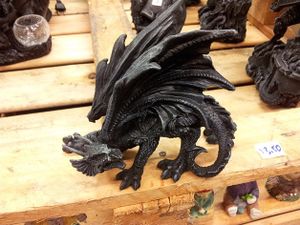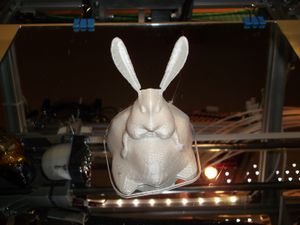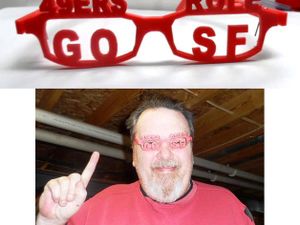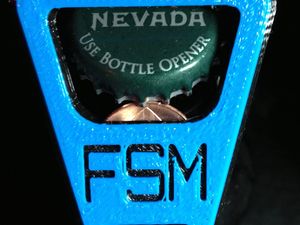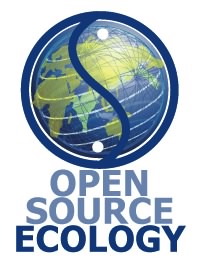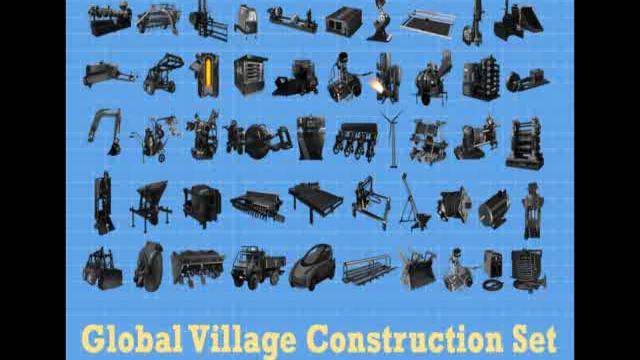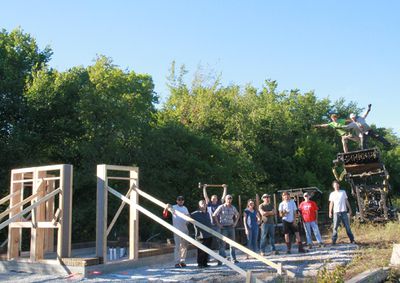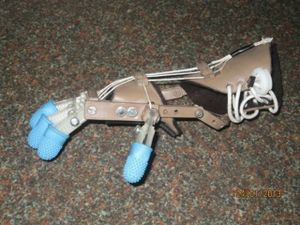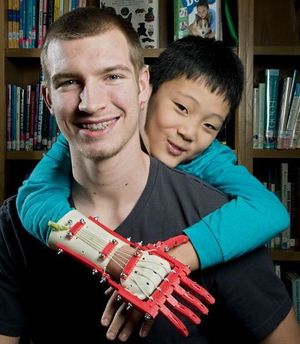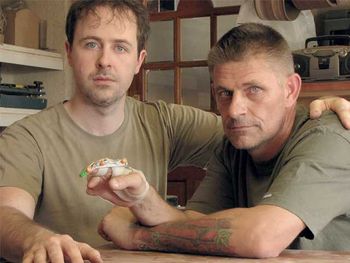User:Heisenberg Jones/Blog
Blog 1: Thingiverse Scavenger Hunt
My first task was to explore the open-source 3D model site Thingiverse and share various types of designs with the class. Thingiverse
1)Something amazing/beautiful
This stunning dragon must have taken ages to design. The level of detail put into the scales and face, not to mention the overhang of the wings and head, is incredible. I suppose the person who designed it was a graphic / mixed media artist to begin with, but it's neat to think that instead of being done by hand (where the subtractive medthod comes in handy for quick edits and detailing), this design was engineered to print out as one whole piece. Source
2)Something funny or strange
After several minutes of typing in random search terms in hopes of something mildly funny/unsettling, I typed in "fat", expecting a Peter Griffin head or Jabba the Hutt. Instead, I was treated to a file called Fat Bunbun, what I imagine someone on LSD would see while watching Bugs Bunny. While tempting to print out and present as a gift to your worst enemy, Fat Bunbun has only begun to haunt my dreams...the first night of many. Be warned: while appearing sluggish and stupid, Bunbun's creepiness is compensation enough. Source
Something useless
As someone who was never really into sports (YAY, we scored the points, now we just score more points than the other side, whoo), I already had a bias against these "glasses". However, from a purely functional role, these glasses fail. The point of these glasses is to show support for the 49ers, presumably during a game. I'll bet you can't see the person in front of you, let alone the court, if you wear these to the playoffs. Good effort, but seriously, this is like printing a blindfold. A pirate patch would have been more useful...at least then it can be fun. Source
Something useful
When searching for something useful, the term ubiquitous came to mind. This bottle opener can be assembled by inputting a coin of your choice, and the fact that one can adjust the slot for the coin based on currency/location is handy. But wait, there's more! Imagine: You're at a party with friends, having a good time. You see someone you like with an unopened bottle of...soda. Yeah. But, oh no! Looks like that guy everyone hates has stolen the only bottle opener in the joint. Aha, you say. Here's my chance to be a hero. Suavely walk over to the person you like, and say, "Can I borrow a quarter? I'll make it worth your while." Assemble this reusable bottle opener, open 'er up, and there you have it: you are now the life of the party. Also good for travel (avoid those metal detectors, then just use a coin from your wallet later). Source
Something which surprised me
This statue, while well made, seemed dangerous to be on Thingiverse. Simply put, I was surprised Disney had not sent an army of lawyers to contest their copyright claim on one of the most recognizable rodents in the world. Source
Overall, it was fun exploring Thingiverse and getting a taste for the possibilities of 3D printing. I even saw a model of a heart...seems like a good place to start for a side project or later assignment. From the coolest and most functional to the crappiest and bizarre, Thingiverse has it all.
Blog 2: Open Source Ecology
This week's task was to learn about Marcin Jakubowski's Open Source Ecology Project, a marriage between open source software and industrial machinery essential to jumpstart a civiliation. After delving into the history of the project and reading some reviews of Marcin's work, I had a bit to say on the topic.
1) What is OSE? What do they do? Are they legit?
The OSE GVCS (Global Village Construction Set) reminds me a lot of the G.E.C.K. (Garden of Eden Creation Kit) from the Fallout series: a one stop DIY jackpot ready to jumpstart a community. It aims to provide accessible agricultural and structural machinery to people looking for a functional unit whose schematics can be changed by the community based on direct user feedback (the OSE wiki), not a brand-name luxury device. It sounds like a dream come true for third-world farmers and just average DIY-ers. The goal is philanthropic enough, and has progressed steadily: from the time the TED talk was given, OSE went from 4 functioning industrial machines to 12, with 38 still to go. Along with that, a 3rd party group successfully reproduced one of their machines, the brick press, three years ago. I also found out that the entire team working at Factor e farm works on a meager budget of $4000/month, yet according to the Gantt chart below, are aiming to knock out 1-3 technologies per month while expanding. While I'm impressed with their ambition, I doubt that the 20-member staff can accomplish that level of production.
One thing I both appreciate and distaste is OSE's "build days". Marcin invited donors who donated $256 or more to the Kickstarter to "get their hands dirty" and help with the construction of a prototype. While it is a good way to gain capital, it would have been far better to hold an open-build day open to the public. It would have stirred up much interest, and shown that OSE was more community-oriented. OSE is, however, reaching out across the world, collaborating in open-source fashion. Overall, I give OSE the thumbs up, and believe that if they expand a bit more, the 50 piece GVCS will be completed before 2030.
2) A critique by The New Yorker, and Marcin's witty retort
While I could only access Page 1 of the New Yorker Article, I gleaned enough from that page and Marcin's response to get the main points. The New Yorker published an article about Marcin's Factor e farm in Missouri, and rather than focus on the devices and technology being developed there, they chose instead to write a profile piece on Marcin combined with a description of the "failed commune" he runs. They criticized the harsh living conditions on the farm, anything from extreme temperatures to lack of amenities. They make Marcin seem like a slave driver pushing his volunteers during the 40 hours/week of work. Marcin responded to The New Yorker's accusations with a post on the OSE wiki page with a fair amount of sardonic wit. He would rather they had focused on the goals of the project than the community he created, which he claimed was "only one instance of the numerous applications of our work." I found the New Yorker article to be, as Marcin put it, melodramatic. The volunteers at Factor e farm know what they are getting themselves into: they want to do a hard day's work and help test a bridge between open source software and the resulting hardware. If other people don't think the conditions are appropriate, why not judge monks living in harsh mountain monasteries in Nepal? In another publication, "Mechanical Engineering Magazine", Associate Editor Jeffrey Winters stated of OSE: "These guys aren’t Amish—they want to build their own car. They believe in technology. They just want it created and used at a more human scale." That said, Marcin does state that Factor e farm is "an experiment", and while the final result is unclear, he believes that recent organizational shifts (team and department leads), will prove useful. Also, he plans to build a recreational area for the workers on the farm, which may make the tough conditions a little more bearable. As an optimist at heart, I choose to side with Marcin; he is a man with a plan and an unceasing fount of enthusiasm for his dream. If others share his dream, they will join in.
3) What if OSE spread to PSU?
I can think of two professors here at PSU who would be interested in an OSE extension or club. Scarlett Miller, who taught my EDSGN 100 class, is interested in the Industrial Engineering Design process: how it has changed from the past, how different people brainstorm, and how designs evolve over time. This is reminiscent of Marcin's idea of OSE as an experiment; there is as much to learn about the process of prototyping as there is about the capabilities. The second professor I would want on my team is Dr. Stephen van Hook, a physics PhD and avid DIY-er. He has constructed his own guitar and many other various projects, and endorses community coming together through a student forum on a site called piazza. There, students are encouraged to work together to learn more.
Sources:
OSE Kickstarter Page [1]
The OSE wiki [2]
Wikipedia Article on OSE [3]
Marcin's 2011 TED Talk [4]
New yorker article: [5]
Marcin's response: [6]
Quote from Mechanical Engineering Magazine [7]
Blog 3: Robohand
How 3D Printing has the fundamental ability to improve a person's quality of life
Back in May of 2011, Robohand designer Richard Van As lost a finger and portions of his other fingers on his right hand. As a practicing woodworker in , he researched several prosthetics online, but it was only when he saw the work of mechanical prop designer Ivan Owen that he discovered a design concept he really liked. Basing their design off of puppets Owen had created, the pair originally meant to return the functionality of Robert's finger with a simple prosthetic. However, when they were asked to create a prosthetic hand for Liam, a boy who was born without fingers on one hand, they expanded their design. The very first Robohand was completed in November 2012 in Van As's native South Africa.
Now flash forward to January 2013. By this point, Makerbot had donated 2 3D printers to Van As and Owen, and their first design was up on Thingiverse [8], where it is still available for download. They established Robohand as an open-source service, and have helped 200 people to date. Richard put it best, when he said, "Not only did we find a design partner, but we’re kindred spirits in that we're both frustrated by the fact that there are some things that just shouldn’t be commercialized—they're needs instead of wants—that are." [9] Since the design to print the hand was available to everyone for free (Robohand accepts donations rather than charging), the design empowers amputees and those with limb difference alike across the globe. That's how 16 year old Mason Wilde was able to print a Robohand for Matthew, a boy in his hometown in Kansas.
The choice Van As and Owen made was a philanthropic one; they very well could have commercialized their product and sold it to humanitarian organizations, possibly copyrighting it. Instead, they worked furiously to get their project going for Liam and hundreds more in need. I believe it was Van As's experience of losing his dominant hand's ability that evoked this hectic pace, creating a functioning prototype in less than a year. The irony of the situation is that they received help from Makerbot. Makerbot was once a non-profit open source project as well, but today they have evolved into a popular DIY business, selling 3D printers for domestic and industrial use. In contrast, I could download the major components (sans harness) of the Robohand today for free, and have a functional hand printed in 8 hours.
The Robohand project has widespread exposure. The story of initial build was published in South Africa Popular Mechanics [10], tech news sites and blogs [11][12], and even the Wall Street Journal.[13] Other stories of Robohand changing the lives of people like Liam have also cropped up, on local news sites like Kansas City Star[14] and prolifically on the Robohand Blog.[15]
The article in the Star showcased the fact that anyone can use 3d printing to improve the lives of people around them. With good initiative and an urge to better the world, we can all be creators. While others choose to print gun components (that's a whole other story / fiasco), individuals like Mason, Van Ans, and Owen are choosing to create for good.
